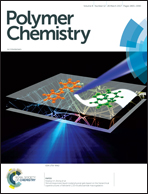Stimuli-responsive liquid crystal physical gels based on the hierarchical superstructures of benzene-1,3,5-tricarboxamide macrogelators†
Abstract
For the fabrication of rewritable electro-optic devices, we prepared randomly dispersed liquid crystal physical gels (LCPG) by constructing a well-defined hierarchical superstructure of a benzene-1,3,5-tricarboxamide (BTA)-based macrogelator (abbreviated BTA3AZO) in a host nematic (N) LC medium. The programmed BTA3AZO macrogelator in the NLC medium built up three-dimensional networks not only by hydrogen-bonding between BTA cores but also by nanophase separations between BTA3AZOs and NLCs. On the basis of the anisotropic optical properties of LCPGs, it was realized that a light scattering state of BTA3AZO LCPGs can be switched to a transmittance state under a fairly low driving voltage (22 V) compared with those (around 100 V) of polymer-based systems. The lower driving voltage of BTA3AZO LCPGs should be mainly due to the formation of self-assembled BTA3AZO nanocolumn networks (only 1 wt%) which were finely dispersed in the NLC medium as well as the good affinity between NLCs and azobenzene mesogens (AZOs) which also responded to the applied electric fields. The BTA3AZO LCPGs can be remote-controlled by utilizing the trans–cis photoisomerization of the azobenzene moieties in the LCPGs. Additionally, the rewritable electro-optical properties of BTA3AZO LCPGs allowed us to demonstrate remote-controllable light shutters.



 Please wait while we load your content...
Please wait while we load your content...